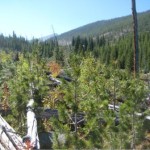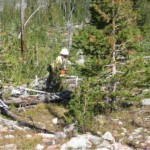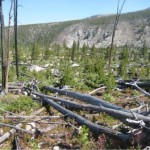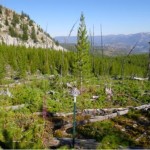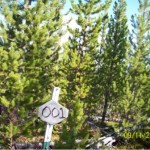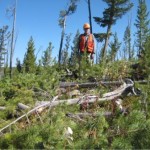2011 Barker Lake Thin Study: Reducing Competing Vegetation to Promote PIAL
Project: Barker Lake Thin Study: Reducing competing vegetation to promote PIAL
Agency/Forest or Park/District:Barker Lake area, Pintler Ranger District, Beaverhead-Deerlodge National Forest
Project coordinator: Rob Gump
Contact: Rob Gump; Beaverhead-Deerlodge Forest Silviculturist-Ecologist; 420 Barrett Street, Dillon, MT, 59725; 406-683-3965; rgump@fs.fed.us
Cooperators: None
Source of funding /amount
FHP: 25,000 and USDA Forest Service Region 1 $25,000
Supplemental funding: $22,500 from NFVW, NFWF, NFIM and RAC
Funding sources:
FY2011
SRS2: $17,500 (RAC funds)
SPFH: $25,000
NFIM: $2,079
NFWF: $747
FY2012
SRS2: $4,814 (RAC funds)
NFRR: $3,161
Dates of restoration efforts
September 2012
Objectives
Reducing competing vegetation from other conifer species, and the monitoring of growth response by PIAL. A portion of the plots were installed in 2009 with whitebark pine restoration program dollars, and this proposal implements the needed thinning to then conduct future monitoring on growth response as well as completes the plot installation. This is a unique old burn area that has a great variety of tree species, with PIAL being well established after the fire. The goal is to prolong the period when PIAL are present by reducing competition with other conifer species—these other species are beginning to outcompete PIAL in this area. In addition, there is mountain pine beetle pressure in the area that is expected to continue over the next three to four years; thinning would increase vigor and reduce the susceptibility of the retained PIAL trees to the beetle. The final objective is to monitor the growth response with varying thinning densities.
Acres/ha treated
75 acres of thinning within a 380-acre area that had burned in 1979
Methods
Thin at varying densities (12’x12’, 16’x16’ and 20’x20’), with each thinning density to cover 25 acres, for a total of 75 acres thinned. Retention of PIAL in the thinning plots would be variable – if a clump of PIAL occurs, the clump would be retained, with the spacing around the clump applied. Where PIAL doesn’t occur within the given spacing, other species would be retained (with a preference to aspen). Thinning will be done by service contract. Permanent plot centers previously installed will be checked and additional plots would be installed; re-measure plots would occur in 5 years.
Planting? If so, source of seedlings? Resistance? No
Outcome
Contract has been awarded. Thinning work will commence in spring of 2012.
Monitoring the results of whitebark pine restoration treatments with pre-treatment and post-treatment measurements will provide critical information on the effectiveness of improving PIAL growing conditions. This is a unique area of well established PIAL saplings; it is expected that the varying thinning densities will provide some guidance for improving vigor of PIAL in other young stands on the Beaverhead-Deerlodge, and possibly in other locations within Region One. Once thinning is complete monitoring will begin.
The thinning contract completed all work obligations in September, 2012. The monitoring plots were installed. Please look at attached photos below.
Monitoring since completion of the project
Dates September, 2012
Plans for future monitoring? September, 2014: additional plots outside of the thinning unit to facilitate a control to the thinned plots. September, 2017: re-measure the thinned plots and the control plots.
Will outcome meet goals?
The thinning work completed nearly met the goals. We were not able to facilitate the structured varying densities as described in the proposal due to difficulties with the service contract. However, we were able to leave the existing PIAL, which in essence left varying densities. Our monitoring over time should still provide us with useful information on variable densities.
Future actions/follow up?
We will be adding monitoring plots outside of the thinned to serve as a control for the plots within the thinning unit. That work will take place this coming summer.
Miscellaneous comments
Below are the changes that occurred in the 75-acre unit with the thinning.
| Pre-treatment Stand Conditions | Post-treatment Stand Conditions |
| Average Tree Height: 12’; 3-30’ Range | Average Tree Height: 8’; 3-30’ Range |
| Average TPA: 4,500; 2,000-8,000 Range | Average TPA: 600; 300-900 Range |
| Spp. Composition: 75-85% LP; 10-20% WBP; <5% ES/SAF | Spp. Composition: 80-90% WBP; 10-20% LP; <5% ES/SAF |
| Estimated Canopy Cover: 26-40% | Estimated Canopy Cover: 10-25% |
| Average Diameter: 3-4” dbh | Average Diameter: .5-2” dbh |
